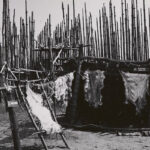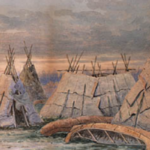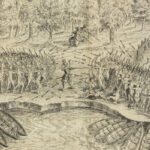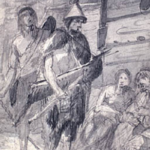Chippewas of the Thames First Nation: A Legacy of Anishinaabe Resilience and Adaptation
The Chippewas of the Thames First Nation, located in southwestern Ontario along the banks of the Thames River, holds a unique place in the history of Canada. As a proud Anishinaabe (Ojibwe) community, their history spans millennia, marked by resilience, adaptation, and a commitment to preserving their cultural identity. From their pre-contact origins and relationships with European explorers to their modern development, the Chippewas of the Thames embody the strength and adaptability of the Anishinaabe people.
Pre-History: The Anishinaabe and the Land
The Chippewas of the Thames are part of the broader Anishinaabe Nation, which has inhabited the Great Lakes region for thousands of years. Their traditional territories included vast tracts of land across present-day Ontario, Michigan, and beyond. Guided by the spiritual teachings of the Seven Fires Prophecy, the Anishinaabe migrated westward from the Atlantic coast, settling around the Great Lakes.
The Thames River and its surrounding lands were central to the lives of the Anishinaabe. The river provided fish and transportation routes, while the fertile lands supported hunting, farming, and gathering. These resources were not only essential for survival but also deeply connected to their spiritual beliefs and cultural practices.
Anthropologist Robin Ridington, in Trail to Heaven: Knowledge and Narrative in a Northern Native Community, reflects, “For the Anishinaabe, the land and water were not merely resources but living entities that sustained the physical and spiritual health of the community.”
Governance and Social Structure
The governance of the Chippewas of the Thames reflected traditional Anishinaabe values of respect, consensus, and collective responsibility. Leaders were chosen for their wisdom and ability to guide the community, while elders played a critical role as custodians of spiritual and cultural knowledge.
The dodem (clan) system formed the foundation of Anishinaabe social structure. Each clan had specific roles and responsibilities, such as leadership, healing, or teaching. This structure ensured a balance within the community, fostering unity and resilience.
Ceremonial practices, including the Midewiwin Society’s teachings, were central to community life, reinforcing the Anishinaabe’s spiritual connection to the land and their shared history.
First Contact with Europeans
The arrival of French explorers in the 17th century marked the beginning of sustained interactions between the Anishinaabe of the Thames River and Europeans. The fur trade became a defining aspect of these early relationships, as the Anishinaabe acted as trappers, guides, and intermediaries between European traders and more remote Indigenous communities.
The French introduced goods such as firearms, metal tools, and textiles, which were eagerly incorporated into Anishinaabe life. However, the fur trade also brought significant challenges, including the overharvesting of animals and the spread of European diseases like smallpox and influenza, which devastated Indigenous populations.
Historian Bruce Trigger, in Indigenous Peoples of Canada, notes, “The fur trade reshaped the social and economic landscape of the Great Lakes, drawing Indigenous nations into global markets while exposing them to profound disruptions.”
Relationships with Settlers and Colonial Powers
By the 18th century, the Chippewas of the Thames were navigating complex relationships with European settlers and colonial powers. They played a key role in the Seven Years’ War (1756–1763) and later in the American Revolutionary War (1775–1783), aligning with the French and British at different times to protect their lands and way of life.
Following the American Revolution, the influx of Loyalist settlers into southern Ontario increased pressures on Indigenous lands. Treaties were negotiated to establish boundaries and secure peace, but these agreements often favoured settler interests. The McKee Purchase (1790), Longwoods Treaty (1822), and other land agreements saw large portions of Anishinaabe territory ceded to the Crown.
Despite these losses, the Chippewas of the Thames maintained their sovereignty and cultural identity, adapting to the changing political and economic landscape while asserting their rights.
Development Under the Reserve System
The establishment of reserves under the Indian Act (1876) confined Indigenous communities to small portions of their traditional territories. The Chippewas of the Thames’ reserve, located along the Thames River, became the focal point of their community life. However, the imposition of the reserve system disrupted traditional governance and restricted access to vital resources.
The introduction of residential schools further compounded these challenges. Children from the Chippewas of the Thames were forcibly removed from their families and placed in institutions where they were prohibited from speaking Anishinaabemowin (Ojibwe language) or practising their traditions. These schools sought to assimilate Indigenous children into Euro-Canadian society, leaving a legacy of trauma that continues to affect the community today.
Resilience and Cultural Revitalization
Despite the disruptions of colonization, the Chippewas of the Thames have demonstrated remarkable resilience. Efforts to preserve and revitalise Anishinaabemowin, as well as traditional ceremonies and teachings, have been central to their resurgence. Programs focused on cultural education and language immersion ensure that younger generations remain connected to their heritage.
Annual events, such as the Chippewas of the Thames Powwow, celebrate the community’s traditions and provide opportunities for cultural exchange. These gatherings highlight the enduring strength and pride of the Chippewas of the Thames people.
Chief Jacqueline French, in a 2021 interview with CBC News, stated, “Our culture and language are the foundation of who we are as a people. By embracing our identity, we are building a future that honours our past.”
Environmental Stewardship and Advocacy
The Chippewas of the Thames have long been stewards of the Thames River and its surrounding lands. Traditional ecological knowledge informs their practices in hunting, fishing, and resource management. In recent years, the community has taken a leading role in addressing environmental challenges, such as water quality and the impact of industrial development on their territory.
Their advocacy extends to treaty rights and land claims. The 2017 Supreme Court decision in Chippewas of the Thames First Nation v. Enbridge Pipelines Inc. reaffirmed the need for meaningful consultation with Indigenous communities on projects affecting their lands and resources. This victory was a significant milestone in the nation’s ongoing efforts to assert their sovereignty and protect their environment.
Chippewas of the Thames Today
Today, the Chippewas of the Thames First Nation is a thriving community of approximately 2,000 members, blending traditional practices with modern governance and economic innovation. Investments in renewable energy, education, and housing reflect their commitment to sustainability and self-determination.
The nation’s leadership in cultural revitalization, environmental stewardship, and treaty advocacy serves as an inspiration for other Indigenous communities across Canada. Their efforts highlight the enduring legacy of the Anishinaabe people and their contributions to the broader Canadian narrative.
Conclusion: A Legacy of Strength and Renewal
The history of the Chippewas of the Thames First Nation is a testament to the resilience, adaptability, and enduring spirit of the Anishinaabe people. From their pre-contact traditions and early relationships with European settlers to their modern advocacy for cultural preservation and environmental justice, the Chippewas of the Thames have maintained their identity and place within Canada’s evolving landscape.
As Chief Jacqueline French stated, “Our story is one of resilience and pride. By honouring our past and protecting our future, we are ensuring that the Chippewas of the Thames remain strong for generations to come.”
References
- Ridington, Robin. Trail to Heaven: Knowledge and Narrative in a Northern Native Community. Douglas & McIntyre, 1988.
- Trigger, Bruce G. Indigenous Peoples of Canada. McGill-Queen’s University Press, 1992.
- Conrad, Margaret. A Concise History of Canada. Cambridge University Press, 2012.
- Johnston, Basil. Ojibway Heritage. McClelland & Stewart, 1976.
- Harris, Cole. The Resettlement of British Columbia: Essays on Colonialism and Geographical Change. UBC Press, 1997.
- Chippewas of the Thames First Nation. Guardians of the Thames: The History and Culture of Chippewas of the Thames. Chippewas Publications, 2015.
- French, Jacqueline. “Protecting Our Future: The Leadership of Chippewas of the Thames.” CBC News, 2021.
- Treaty Elders of Ontario. Voices of the Great Lakes: Stories from Anishinaabe Communities. University of Toronto Press, 2005.
- Supreme Court of Canada. Chippewas of the Thames First Nation v. Enbridge Pipelines Inc. (2017).
- Environmental Justice Advocacy Group. Waterways and Rights: The Chippewas of the Thames in Environmental Justice. University of Windsor Press, 2018.



